The Brazos Review: AMD's E-350 Supplants ION for mini-ITX
by Anand Lal Shimpi on January 27, 2011 6:08 PM ESTAMD has been curiously absent from the value netbook and nettop segments since Atom’s arrival nearly three years ago. These markets are highly profitable only for component vendors, as the OEMs that sell netbooks and nettops must survive on very slim margins in order to hit aggressive price points. It wasn’t too long ago that we were shocked by $699 desktop PCs, but to now be able to get a fully functioning portable PC with display at below $300 is impressive. In order for the profit equation to work out however, you can’t simply scale down a larger chip - you need an architecture targeted specifically at the type of very light workloads you expect to encounter in these segments. Underclocking and undervolting an architecture targeted at high end desktops or servers won’t cut it.
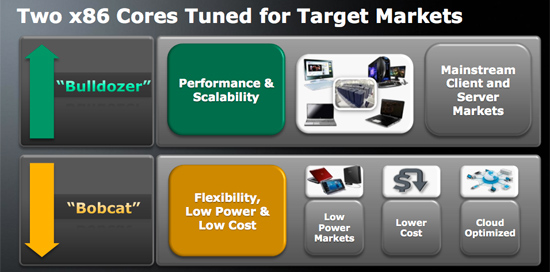
Generally a single microprocessor architecture can cover an order of magnitude of power envelopes. You can take an architecture from 10W - 100W using clock speed, voltage scaling and disabling features (e.g. cutting cache sizes). You can’t efficiently take a 100W architecture and scale it down to 1W. Intel realized this with Atom, and what resulted was a new architecture designed to span the 0.5W - 5W range. Given the constraints of the process (Atom was built at 45nm) and a desire to keep die size down to a minimum (and thus maximize profits), Intel went with a dual-issue in-order architecture reminiscent of the old Pentium - but with a modern twist.
AMD came to the same realization. For it to compete in these value markets, AMD couldn’t rely on its existing Phenom II derived architectures. The Phenom II and its relatives currently span a range of TDPs from 9W to 140W, and at the lower end of that spectrum we’re talking about some very low clock speeds and performance targets. Getting down to 1W was out of the question without a separate design.
What AMD came up with was a core called Bobcat, initially targeted for netbooks, notebooks, nettops and entry level desktops. Architecturally Bobcat is a significant step ahead of Atom: while still dual-issue, it features an out-of-order execution engine making it the Pentium Pro to Atom’s Pentium.
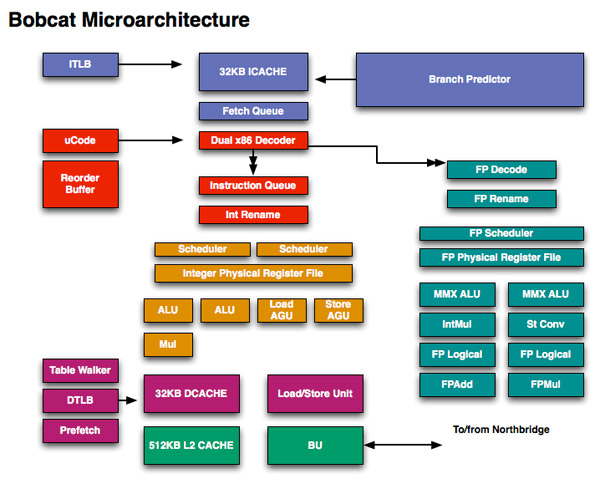
It isn’t just CPU architecture that AMD surpassed Atom with, the first incarnation of Bobcat is an integrated SoC with on-die DirectX 11 GPU. AMD calls this combination a Fusion APU (Accelerated Processing Unit) as it places both a CPU and GPU on a single die. The possible CPU/GPU combinations for Bobcat based APUs are listed in the table below:
| AMD Brazos Lineup | ||||||||
| APU Model | Number of Bobcat Cores | CPU Clock Speed | GPU | Number of GPU Cores | GPU Clock Speed | TDP | ||
| AMD E-350 | 2 | 1.6GHz | Radeon HD 6310 | 80 | 500MHz | 18W | ||
| AMD E-240 | 1 | 1.5GHz | Radeon HD 6310 | 80 | 500MHz | 18W | ||
| AMD C-50 | 2 | 1.0GHz | Radeon HD 6250 | 80 | 280MHz | 9W | ||
| AMD C-30 | 1 | 1.2GHz | Radeon HD 6250 | 80 | 280MHz | 9W | ||
AMD avoided branding its first APUs, they’re simply the AMD E-series and C-series Fusion APUs. The emphasis isn’t on the CPU or the GPU in this case, just the company name and a model number.
| CPU Specification Comparison | ||||||||
| CPU | Manufacturing Process | Cores | Transistor Count | Die Size | ||||
| AMD Zacate | 40nm | 2 | ? | 75 mm2 | ||||
| AMD Thuban 6C | 45nm | 6 | 904M | 346mm2 | ||||
| AMD Deneb 4C | 45nm | 4 | 758M | 258mm2 | ||||
| Intel Gulftown 6C | 32nm | 6 | 1.17B | 240mm2 | ||||
| Intel Nehalem/Bloomfield 4C | 45nm | 4 | 731M | 263mm2 | ||||
| Intel Sandy Bridge 4C | 32nm | 4 | 995M | 216mm2 | ||||
| Intel Lynnfield 4C | 45nm | 4 | 774M | 296mm2 | ||||
| Intel Clarkdale 2C | 32nm | 2 | 384M | 81mm2 | ||||
| Intel Sandy Bridge 2C (GT1) | 32nm | 2 | 504M | 131mm2 | ||||
| Intel Sandy Bridge 2C (GT2) | 32nm | 2 | 624M | 149mm2 | ||||
These APUs do need the aid of an additional chip - the Hudson Fusion Controller Hub (FCH). The FCH adds support for things like SATA, USB, Ethernet and Audio.The Hudson FCH is very tiny measuring approximately 4mm x 7mm for a total die size of around 28mm2.
The combination of these Bobcat based APUs and the FCH is called the Brazos platform.
Late last year AMD invited me to spend several hours with a Brazos system at its brand new campus in Austin, TX. While the preview gave us some insight into what we could expect from Brazos, I didn’t have enough time to really dive in as much as I would’ve liked to.
Earlier this month, AMD officially launched Brazos with hardware expected sometime this quarter. For the past couple of weeks I’ve been testing a Brazos mini-ITX motherboard from MSI and today, it’s time to break the silence and share the results. They are quite good.


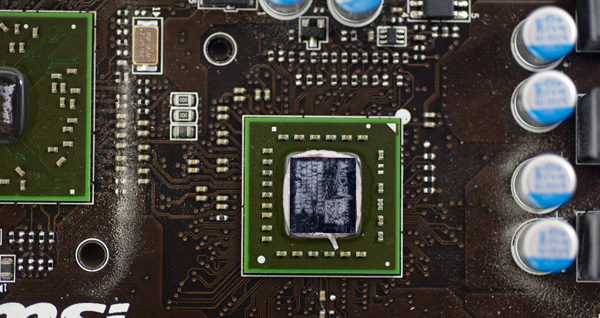
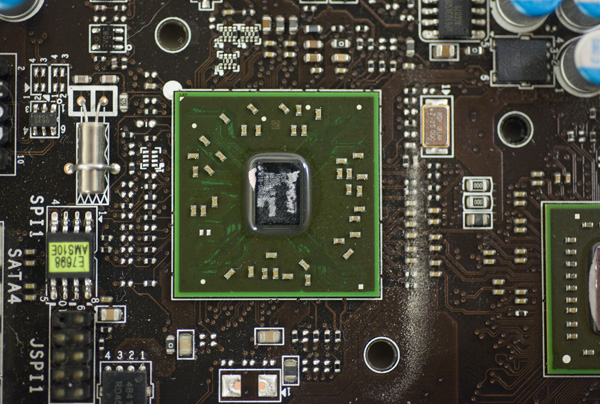
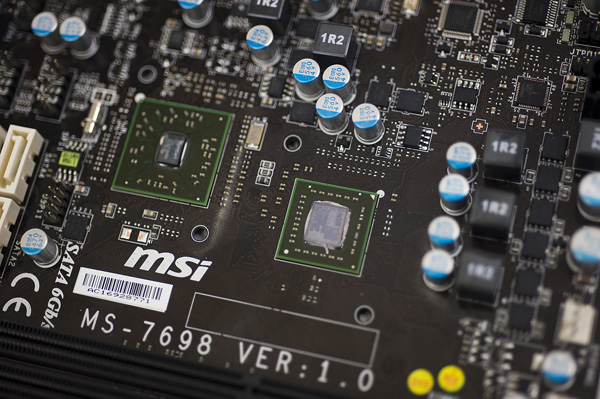
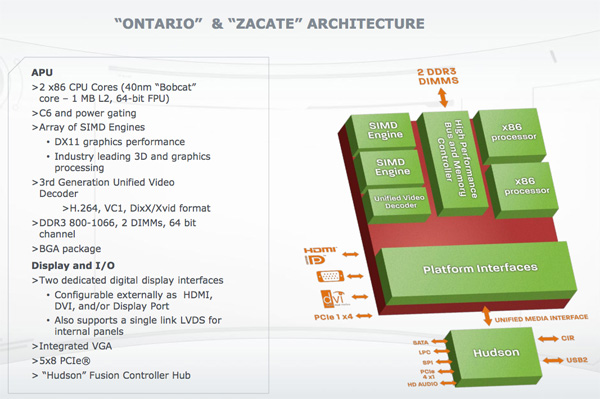








176 Comments
View All Comments
themw6 - Saturday, January 29, 2011 - link
Hi Anand, as many of us are interested in using zacate in a NAS - could you run a quick truecrypt benchmark? I'm especially interested in AES-256 performance. Additionally, network throughput would be great, too ;)Something else: you measured 24 watts idle power consumption. Could you provide more details on your test platform? Others had engineering samples with as little as 11 watts at idle. I'm guessing you used some 850W-rated PSU? ;) Anyway, thanks for the review!
MrSpadge - Saturday, January 29, 2011 - link
With such a low clock speed and such low power draw and a desktop platform, which can easily provide power but needs some more performance.. you'd think AMD would have put a proper Turbo mode in there. 1 thread 2.0 GHz, 2 threads 1.6 GHz - easy.MrS
rashire - Saturday, January 29, 2011 - link
First Thanks to Anand for doing a HTPC review for this chip, I've been waiting on this since your initial comments in Nov.But I'm kind of disappointed after reading the review. While it definitely looks like a better alternative to atom+ion i was just expecting a bit more horse power from it.
I was hoping for a product i was certain would have the power to do downloads, archive extraction and other CPU intensive processes in the background while doing 1080p playback or running an emulator in the foreground. And from the review i just don't see enough power to be sure my media and data-storage processes without potentially maxing out the CPU under certain combinations.
Looking forward to next gen discrete solution to replace my mid-tower HTPC.
GullLars - Sunday, January 30, 2011 - link
I'd like to see a clock for clock comparison of Bobcat, Athlon II, Phenom II, Atom, Core, Nehalem, and Sandy Bridge.From what i can see in these graphs, Bobcat performs about 60-90% of Athlon II clock for clock.
I look forward to seeing overclocking of bobcat :)
Malih - Sunday, January 30, 2011 - link
Zacate (board) ~$100WiFi ~$25
small Case ~$75
PSU ~$50
4GB RAM ~$50
widescreen LCD ~$125
storage ~$100
around $500 for a good enough complete system, but of course you can always get cheaper case, PSU, storage, LCD and 2GB RAM
THE_DOM!NAT0R - Monday, January 31, 2011 - link
The mini-ITX boards based on Brazos are quite good as it seems. They surpass Atom for HTPC's and have more features like more sata ports. I would like to see a comparison with about 5 mini-itx Brazos boards by Anand. Also, if you have a power supply that is rated for max efficiency at about 15-30 W, you can accurately compare the power figures between Brazos boards and Atom. I've seen some reviews and they use power supplies that are rated at about 300W; their lowest reasonable efficiency is 10% load, that isn't designed for 15<P<30.MrMilli - Monday, January 31, 2011 - link
I would really like to see a comparison against the Athlon II 250u.jamesgor13579 - Monday, January 31, 2011 - link
Until it can replace my ION/Linux/XBMC system, I am not interested. AMD has been doing well on the Linux front recently, but I don't know about their video decode.Metaluna - Monday, January 31, 2011 - link
I'm also interested in how these boards perform in Linux (or even if the new GPU is supported at all in current mainstream distros like Ubuntu 10.10). I'm interested in building a small nettop, mostly for web browsing but possibly HTPC use at some point.Jeffk464 - Tuesday, February 1, 2011 - link
"The good news is 1080i60 works just fine.Brazos’ GPU also fails all of our deinterlacing tests,"
The second sentence follows the first one and seems to directly contradict it. I was planning on buying one of these for a htpc and the ability to play 1080i60 as well as 1080p24 are absolutely critical. 1080i60 is one of the main standards of broadcast(over the air TV) and 1080p24 is the standard for blue ray. So my question then becomes since the author seems to have contradicted himself can brazos handle the interlaced 1080i60 content? This article should have cleared things up not made it more confusing.